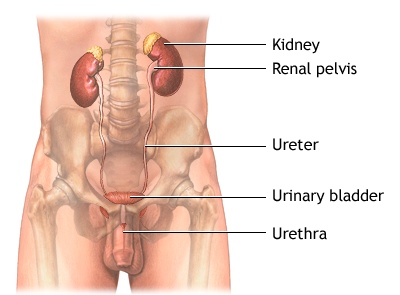Urinary incontinence
Contents
What is urinary incontinence?
Are there different types of incontinence?
Is urinary incontinence just part of growing older?
What causes incontinence?
Causes of urinary incontinence
How can it be treated?
What are Kegel exercises?
Kegel exercises
What is bladder training?
Will medicine or surgery help?
What is urinary incontinence?
Urin
ary incontinence is the loss of bladder control. This means that you can't always control when you urinate. Urinary incontinence can range from leaking a small amount of urine (such as when coughing or laughing) to having very strong urges to urinate that are difficult to control. This can be embarrassing, but talk to your doctor about it. It can be treated.

Female urinary system
Male urinary system
Millions of adults have urinary incontinence. It's most common in people older than 50 years of age, especially women. But it can also affect younger people, especially women who have just given birth.
Be sure to talk to your doctor if you have this problem. If you hide your incontinence, you risk getting rashes, sores, skin infections and urinary tract infections. Also, you may find yourself avoiding friends and family because of fear and embarrassment.
Are there different types of incontinence?
Yes. There are 5 types of urinary incontinence. A brief explanation of each follows.
Stress incontinence
Stress incontinence is when urine leaks because of sudden pressure on your lower stomach muscles, such as when you cough, laugh, lift something or exercise. Stress incontinence usually occurs when the pelvic muscles are weakened, for example by childbirth or surgery. Stress incontinence is common in women.
Urge incontinence
This occurs when the need to urinate comes on very suddenly, often before you can get to a toilet. Your body may only give you a warning of a few seconds to minutes before you urinate. Urge incontinence is most common in the elderly and may be a sign of a urinary tract infection or an overactive bladder.
Overflow incontinence
This type of incontinence is the uncontrollable leakage of small amounts of urine. It's caused by an overfilled bladder. You may feel like you can't empty your bladder all the way and you may strain when urinating. This often occurs in men and can be caused by something blocking the urinary flow, such as an enlarged prostate gland or tumor. Diabetes or certain medicines may also cause the problem.
Functional incontinence
This type occurs when you have normal urine control but have trouble getting to the bathroom in time. You may not be able to get to the bathroom because of arthritis or other diseases that make it hard to move around.
Mixed incontinence
This type involves more than one of the types of incontinence listed above.
Is urinary incontinence just part of growing older?
No. But changes with age can reduce how much urine your bladder can hold. Aging can make your stream of urine weaker and can cause you to feel the urge to urinate more often. This doesn't mean you'll have urinary incontinence just because you're aging. With treatment, it can be controlled or cured.
What causes incontinence?
Urinary incontinence can be caused by many different medical problems, including weak pelvic muscles or diabetes. See the box below for a list of common causes.
Causes of urinary incontinence
· For women, thinning and drying of the skin in the vagina or urethra, especially after menopause
· For men, enlarged prostate gland or prostate surgery
· Weakened and stretched pelvic muscles after childbirth
· Certain medicines
· Build-up of stool in the bowels
· Overweight and obesity, which increase pressure on the bladder and muscles that control the bladder
· Urinary tract infections
· Vascular disease
· Diseases such as diabetes, Alzheimer's disease and multiple sclerosis
How can it be treated?
Treatment depends on what's causing the problem and what type of incontinence you have. If your urinary incontinence is caused by a medical problem, the incontinence will go away when the problem is treated. Kegel exercises and bladder training help some types of incontinence through strengthening the pelvic muscles. Medicine and surgery are other options.
What are Kegel exercises?
Stress incontinence can be treated with special exercises, called Kegel exercises (see the box below). These exercises help strengthen the muscles that control the bladder. They can be done anywhere, any time. Although designed for women, the Kegel exercises can also help men. It may take 3 to 6 months to see an improvement.
Kegel exercises
- To locate the right muscles, try stopping or slowing your urine flow without using your stomach, leg or buttock muscles. When you're able to slow or stop the stream of urine, you've located the right muscles.
- Squeeze your muscles. Hold for a count of 10. Relax for a count of 10.
- Repeat this 10 to 20 times, 3 times a day.
- You may need to start slower, perhaps squeezing and relaxing your muscles for 4 seconds each and doing this 10 times, 2 times a day. Work your way up from there.
What is bladder training?
Bladder training is a way of learning to manage urinary incontinence. It is generally used for stress incontinence, urge incontinence or a combination of the 2 types (mixed incontinence)..
Will medicine or surgery help?
Medicine helps some types of urinary incontinence. For example, estrogen cream to put in the vagina can be helpful for some women who have mild stress incontinence. Several prescription medicines are available to treat urge incontinence. For men, prescription medicine is available to shrink the prostate and improve flow of urine through the prostate. Talk to your doctor about possible medicine options for your type of incontinence.
Surgery can sometimes be helpful, especially in stress incontinence in women and in overflow incontinence in men due to an enlarged prostate. It is usually only performed if other treatments haven't worked or if the incontinence is severe.


